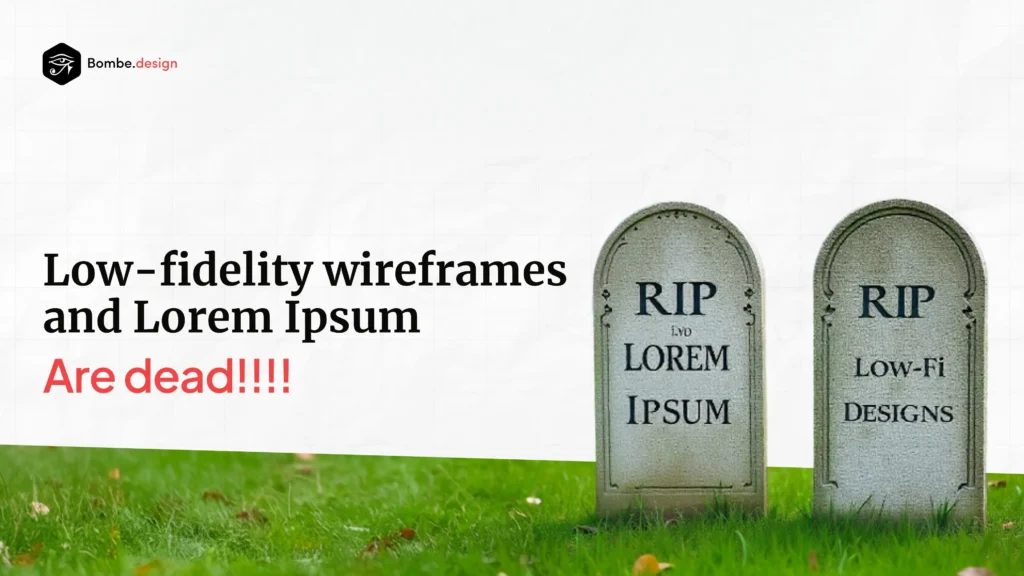What is the Role of AI in Realistic UX prototyping?
For decades, UX designers have relied on low-fidelity wireframes filled with generic placeholder text like “Lorem Ipsum” to sketch out early product concepts. These wireframes made early ideation fast and helped teams align on basic navigation and structure without getting caught up in content or detail.
However, there’s one major flaw with that approach: it rarely reflects real user context. This disconnect often makes it hard to validate user flows, test interactions, or collect meaningful feedback at the early stages. As a result, teams waste valuable time iterating on designs that may not work in the real world.
But that’s changing fast. With AI-powered design tools and intelligent algorithms, UX prototyping is no longer a static process. Today, designers can generate realistic, context-aware prototypes that feel much closer to the final product, right from the very first screen.
What Realistic UX Prototyping Includes
Realistic UX prototyping powered by AI involves much more than placing static boxes and filler text. Instead, it includes several key components:
1. Real Content Instead of Filler
AI tools can auto-generate microcopy, CTAs, headlines, prompts, and even error messages that reflect the actual product’s tone, voice, and user context. This shift offers several clear benefits:
- Wireframes feel more alive: Early screens are relatable, using language that resembles the intended product instead of nonsense Latin.
- Instant validation: Realistic content enables meaningful user testing, helping gather high-quality feedback from day one.
- Stronger team alignment: Stakeholders can understand intent and messaging, not just navigation structure.
2. Dynamic Low-Fidelity, Not Just Static Boxes
Instead of monochrome rectangles, today’s AI-powered design tools (like lovable, Uizard, Galileo AI, and Visily) generate responsive wireframes and semi-functional layouts based on industry, brand style, and anticipated user actions. Key advantages include:
- Layouts tailored to your project: Get context-aware designs e-commerce, fintech, healthcare, and more right from the start.
- Rapid iteration: Designers can quickly test different flows and content combinations, minimizing rework in later stages.
- Accessible prototyping: Non-designers can turn a typed prompt or rough sketch into a near-high-fidelity wireframe instantly.
3. Persona-Aware Prototyping
AI can tap into persona data (demographics, needs, habits) to inform early wireframing. Instead of designing for the mythical “average user,” screens are built for real segments, meaning:
- Personalization from the beginning: Prototypes reflect actual user journeys and language.
- Early detection of pain points: Designers see and solve potential problems before investing heavily.
- Inclusion of diverse perspectives: AI helps consider edge cases and underrepresented users.
4. Smarter Decisions, Less Guesswork
Platforms today use AI to interpret briefs and recommend flows, UI components, and even micro-interactions. This means:
- Automated layout and navigation suggestions optimized for industry standards and best practices.
- Reduced trial and error: AI points designers toward successful structures based on data and prior UX patterns.
- Consistent brand voice: AI maintains alignment with established tone and messaging guidelines.
5. From Sketch to Near-High-Fidelity In Seconds
AI design tools now enable teams to leap from whiteboarding or simple prompts to production-ready prototypes almost instantly. The impact:
- Faster prototyping: Quick ideation means more time to test and refine.
- Better communication: Developers, clients, and stakeholders see exactly what’s intended, so fewer misunderstandings slow the process.
- More room for creativity: Less time on repetitive work allows designers to focus on innovative solutions.
Why AI Isn’t Just Improving UX: It’s Evolving It
This isn’t just about speed or automation. AI-driven UX prototyping is a true evolution of how we define “good design.”
In traditional workflows, teams filled in the gaps with imagination. Now, designers can present testable, realistic UX with real copy and logic baked in right from day one. This tightens feedback loops, aligns cross-functional teams, and allows designers to focus on what really matters: solving user problems through creativity and empathy.
Design becomes data-driven, iterative, and grounded in user reality rather than assumption. The process is more human, not less because we’re no longer wasting time creating abstract placeholders that don’t reflect user needs.
How We Bombe Leading This Shift
At BOMBE, we don’t just adapt to the future, we design with it, today. We’ve fully embraced the AI-powered design revolution, integrating advanced tools that accelerate every step from ideation to development.
With smart platforms like Lovable, generating low-fidelity wireframes is no longer a time-consuming task, it’s almost instantaneous. This drastically speeds up our UX process, enabling us to validate ideas quickly and move into structured design systems faster.
AI models like ChatGPT, Gemini, Claude, and DeepSeek play a crucial role in refining content early in the design cycle. Instead of defaulting to placeholder text like lorem ipsum, we generate context-aware copy that’s aligned with real user goals, improving clarity, communication, and usability from the outset.
This approach minimizes friction, enhances cross-functional collaboration, and lets our designers focus on what really matters: creative problem-solving, user empathy, and building experiences that scale.
The New Standard in UX
AI is redefining early-stage UX prototyping replacing static layouts and generic content with living, user-focused interfaces. This is more than a technical upgrade. It’s a new standard for UX design, one that’s faster, more meaningful, and deeply rooted in real user behavior.
At BOMBE, we’re at the forefront of this transformation. We’re not just making prototypes, we’re designing testable experiences that reflect the future of your product, from the very first screen.
Ready to bring your vision to screens?
Schedule FREE UX Consultation today!

